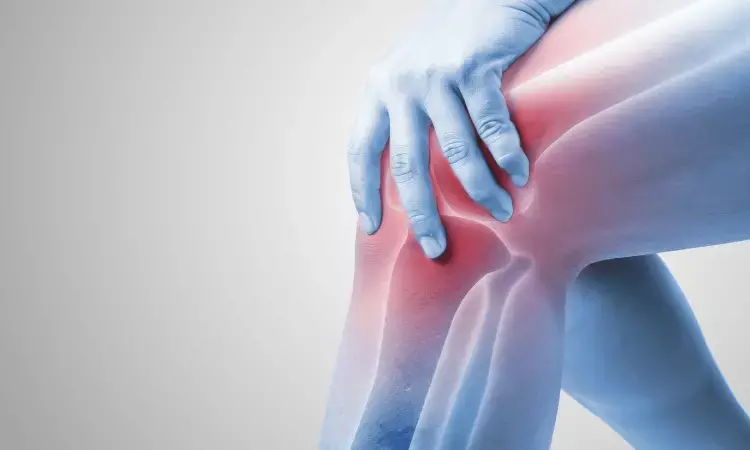- Home
- Medical news & Guidelines
- Anesthesiology
- Cardiology and CTVS
- Critical Care
- Dentistry
- Dermatology
- Diabetes and Endocrinology
- ENT
- Gastroenterology
- Medicine
- Nephrology
- Neurology
- Obstretics-Gynaecology
- Oncology
- Ophthalmology
- Orthopaedics
- Pediatrics-Neonatology
- Psychiatry
- Pulmonology
- Radiology
- Surgery
- Urology
- Laboratory Medicine
- Diet
- Nursing
- Paramedical
- Physiotherapy
- Health news
- Fact Check
- Bone Health Fact Check
- Brain Health Fact Check
- Cancer Related Fact Check
- Child Care Fact Check
- Dental and oral health fact check
- Diabetes and metabolic health fact check
- Diet and Nutrition Fact Check
- Eye and ENT Care Fact Check
- Fitness fact check
- Gut health fact check
- Heart health fact check
- Kidney health fact check
- Medical education fact check
- Men's health fact check
- Respiratory fact check
- Skin and hair care fact check
- Vaccine and Immunization fact check
- Women's health fact check
- AYUSH
- State News
- Andaman and Nicobar Islands
- Andhra Pradesh
- Arunachal Pradesh
- Assam
- Bihar
- Chandigarh
- Chattisgarh
- Dadra and Nagar Haveli
- Daman and Diu
- Delhi
- Goa
- Gujarat
- Haryana
- Himachal Pradesh
- Jammu & Kashmir
- Jharkhand
- Karnataka
- Kerala
- Ladakh
- Lakshadweep
- Madhya Pradesh
- Maharashtra
- Manipur
- Meghalaya
- Mizoram
- Nagaland
- Odisha
- Puducherry
- Punjab
- Rajasthan
- Sikkim
- Tamil Nadu
- Telangana
- Tripura
- Uttar Pradesh
- Uttrakhand
- West Bengal
- Medical Education
- Industry
MRI has limited accuracy in diagnosis of knee injuries limited to Posterolateral corner and meniscus

A recent study published in The American Journal of Sports Medicine has demonstrated the accuracy of MRI for the diagnosis of multiple ligament knee injuries. Researchers reported the highest diagnostic accuracy of 94.4 % with injuries of the anterior cruciate ligament (ACL) and the lowest diagnostic accuracy of 76.2 % with injuries of the popliteus tendon.
It is already known that Magnetic resonance imaging (MRI) has limited diagnostic accuracy for multiple ligament knee injuries (MLKIs), especially posterolateral corner (PLC) injuries. In the present study, researchers developed a hypothesis that the diagnostic accuracy of MRI for MLKIs will only be moderate for some knee structures. Patient-related factors and injury patterns could modify this.
Researchers recorded findings related to sex, age, mechanism of injury, time from injury to MRI, and vascular and neurological-associated lesions. They also collected (MPI reports and surgical records) Lesions to the ACL, PCL, medial collateral ligament, lateral collateral ligament (LCL), popliteus tendon, popliteofibular ligament, iliotibial band, biceps tendon, medial and lateral meniscus, and articular cartilage.
The study results are:
- A total of 178 patients with a mean age of 33 years were included.
- The common causes or mechanisms of injury were High-energy trauma, sports trauma and low-energy trauma, constituting 50.6%, 38.8 % and 8.4 %, respectively.
- ACL had the best diagnostic accuracy, diagnostic odds ratio, and positive predictive value.
- The worst diagnostic accuracy was reported with PLC structures.
- The reliability of MRI was more in detecting the absence of meniscal and chondral lesions than in identifying them.
- The diagnostic accuracy was affected by the Schenck classification.
The diagnostic accuracy of MRI varies for MLKIs. This may become a cause of misdiagnosis. The MLKI's severity lowered the diagnostic accuracy of MRI for peripheral structures.
They said that MRI is better at identifying the absence of meniscal lesions than the presence. The diagnostic accuracy of MRI is limited with more severe injuries.
It is crucial for clinicians to understand that MRI cannot provide imaging of all lesions of knee injuries. They said that Posterolateral corner and meniscus injuries can be missed on MRI.
Further reading:
Sanchez-Munoz E, Lozano Hernanz B, Zijl JAC, et al. Accuracy of Magnetic Resonance Imaging in the Diagnosis of Multiple Ligament Knee Injuries: A Multicenter Study of 178 Patients. The American Journal of Sports Medicine. 2023;51(2):429-436. doi:10.1177/03635465221145697
BDS, MDS in Periodontics and Implantology
Dr. Aditi Yadav is a BDS, MDS in Periodontics and Implantology. She has a clinical experience of 5 years as a laser dental surgeon. She also has a Diploma in clinical research and pharmacovigilance and is a Certified data scientist. She is currently working as a content developer in e-health services. Dr. Yadav has a keen interest in Medical Journalism and is actively involved in Medical Research writing.
Dr Kamal Kant Kohli-MBBS, DTCD- a chest specialist with more than 30 years of practice and a flair for writing clinical articles, Dr Kamal Kant Kohli joined Medical Dialogues as a Chief Editor of Medical News. Besides writing articles, as an editor, he proofreads and verifies all the medical content published on Medical Dialogues including those coming from journals, studies,medical conferences,guidelines etc. Email: drkohli@medicaldialogues.in. Contact no. 011-43720751


